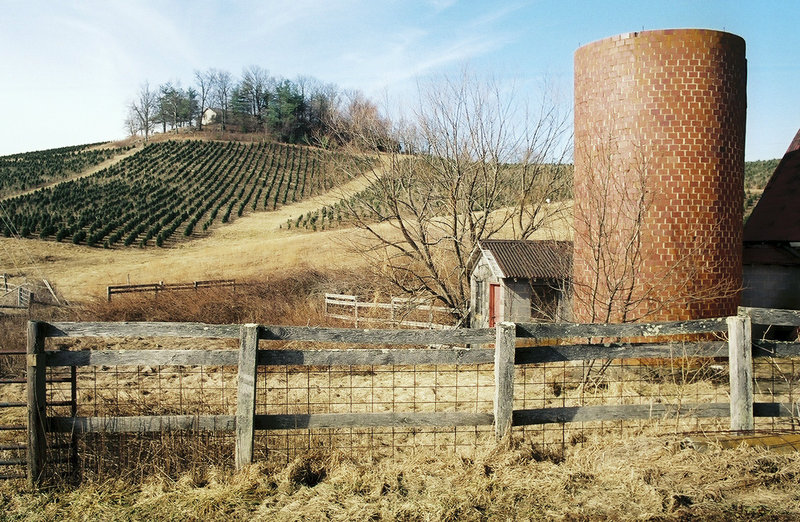SPARTA, N.C. – Without a growing Hispanic population in the rolling hills of rural North Carolina, Bottomley Evergreens and Farms Inc., a provider of Christmas trees to Walmart and Home Depot, would be out of business.
“If it weren’t for the Hispanic people, I couldn’t farm, couldn’t do nothing,” said Blan Bottomley, 64, who has 4.5 million firs planted this year and fields of pumpkins, cabbage and sweet corn taking root nearby.
His son and co-owner Mitchell, 37, said he’s gleaned some know-how from the migrant workers.
“I know how to say, ‘Go cut cabbage’ or ‘Go cut pines,’” he said in Spanish.
The Hispanic population in Alleghany County, at the foothills of the Blue Ridge Mountains, grew 89.4 percent from 2000 to 2010, compared with 4.5 percent overall growth in the county, according to 2010 Census figures released Wednesday.
The increase in Latino residents in North Carolina reflects a broader national trend in which Hispanics are moving beyond urban neighborhoods and making rural America home.
Hispanics in North Carolina rose 111.1 percent during the past decade, and the ethnic group now accounts for 8.4 percent of the state’s population, compared with 4.7 percent in 2000, according to the census data. Details on state populations will be released through the end of March by the Census Bureau.
“There aren’t many Americans who want to work in agriculture,” said Xavier Iglesias, 27, owner of two restaurants and a laundromat in Sparta, the largest town in Alleghany County, in the northwestern part of the state. “It’s such a haven for the migrant worker to come here.”
Alleghany County lost more than 1,000 textile and apparel manufacturing jobs in the past decade, according to Bob Bamberg, executive director of the county’s chamber of commerce. Economic recovery depends upon agriculture, tourism and entrepreneurs, such as Iglesias, he said.
“He’s an example of Latinos who come up here and start businesses,” said Bamberg, 64, who has been in charge of the business organization for five years. Iglesias joined the group’s board of directors last year, an acknowledgment of the growing Hispanic population in the rural area.
“He’s young and outgoing and he speaks perfect English,” Bamberg said of Iglesias. “Our best and brightest kids move away and come back when they retire.”
William Frey, a senior fellow and demographer at the Brookings Institution in Washington, said Hispanics comprise at least 11 percent of the population in four of the state’s five biggest cities. They account for 13.1 percent of residents in Charlotte, where Bank of America is headquartered. According to Frey, the state is poised to have the 11th-largest Latino population in the U.S.
The demographic changes, which helped Barack Obama win the state in the 2008 presidential election, underscore how communities evolve as the Hispanic population fans out.
The state’s white population grew 12.5 percent and accounts for 68.5 percent of the state, down from 72.1 percent in 2000. The black population rose 17.9 percent and makes up 21.5 percent of North Carolinians, little changed from a decade ago, according to the 2010 Census.
The state’s overall population grew 18.5 percent during the past decade, the sixth-fastest in the U.S., compared with 9.7 percent for the nation as a whole, according to government data released Dec. 21.
“My children get to see the diversity in school,” said Della Deal, 34, whose family operates another Christmas tree farm near Sparta and who has twin boys in fourth grade at Piney Creek Elementary School. “They ride the bus with Hispanic children. They’re taking Spanish.”
Buddy Deal, who manages the Smokey Holler Tree Farm, which harvests 30,000 trees a year, said he “developed the ability to speak Spanish because I was the only one who didn’t. I can communicate the points I need to operate the farm.”
His father, Earl, 68, said he first hired a Hispanic worker in 1993 and has seen that labor pool expand.
“I can’t find local people to do this work anymore,” the elder Deal said, adding that he uses workers certified by a U.S. guest worker program, called H-2A, aimed at allowing foreign workers to enter the country for seasonal farm jobs.
“If you come back next year, you won’t see any of these same faces,” Buddy Deal said. “They learn to speak English, they start networking and they find jobs that are higher-paying and easier.”
The jobless rate in North Carolina jumped to 9.8 percent at the end of last year from 3.4 percent in January 2000, according to the U.S. Department of Labor. The national average during that same period climbed to 9.4 percent from 4 percent.
At Bottomley Evergreens & Farms, compensation is based on production, Mitchell Bottomley said, with workers earning about $100 a day making garland or cutting trees for about $225 a day.
“They make dang good money. That’s why we get the help,” he said.
Send questions/comments to the editors.




Success. Please wait for the page to reload. If the page does not reload within 5 seconds, please refresh the page.
Enter your email and password to access comments.
Hi, to comment on stories you must . This profile is in addition to your subscription and website login.
Already have a commenting profile? .
Invalid username/password.
Please check your email to confirm and complete your registration.
Only subscribers are eligible to post comments. Please subscribe or login first for digital access. Here’s why.
Use the form below to reset your password. When you've submitted your account email, we will send an email with a reset code.